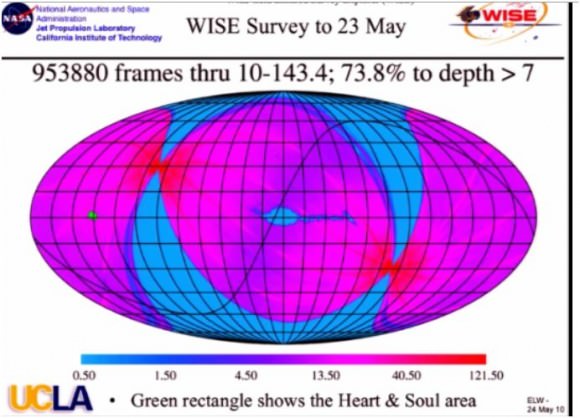[/caption]
In about six months’ time, NASA’s WISE mission, the Wide-field Infrared Survey Explorer, has captured almost a million images, covering about three-quarters, or 30,000 square degrees, of the sky. At the 216th American Astronomical Society meeting today, astronomers released a new mosaic of two bubbling clouds in space, known as the Heart and Soul nebulae.
“This image actually has two hearts; one is a Valentine’s Day heart, and the other is a surgical heart that you have in your body,” said Ned Wright of the University of California, Los Angeles who presented the new picture. “This new image demonstrates the power of WISE to capture vast regions. We’re looking north, south, east and west to map the whole sky.”
To make this huge mosaic WISE stared at this region of space which lies about 6,000 light-years away in the constellation Cassiopeia, for 3.5 hours of total exposure time, taking 1,147 images.
Both these nebulae are massive star-making factories, marked by giant bubbles blown into surrounding dust by radiation and winds from the stars. The infrared vision of WISE allows it to see into the cooler and dustier crevices of clouds like these, where gas and dust are just beginning to collect into new stars.
WISE will complete its first map of the sky in July 2010, and then spend the next three months surveying much of the sky a second time, before the solid-hydrogen coolant needed to chill its infrared detectors runs dry. Wright said the first installment of the public WISE catalog will be released in summer 2011.
Wright marveled at how in the span of his career he has gone from observing in just 4 pixels to now observing with WISE in almost 4 million pixels.
“It’s been an amazing progress in IR astronomy, with cameras growing by a factor of a million in power in just a few decades,” he said.

Spotting NEO’s
One goal of the WISE mission is to study asteroids throughout our solar system and to find out more about how they vary in size and composition. Infrared helps with this task because it can get better size measurements of the space rocks than visible light.
So far, WISE has observed more than 60,000 asteroids, most of which lie in the main belt, orbiting between Mars and Jupiter. About 11,000 of these objects are newly discovered, and about 50 of them belong to a class of near-Earth objects, which have paths that take them within about 48 million kilometers (30 million miles) of Earth’s orbit.
“As WISE is orbiting the Earth, we are sweeping through the solar system like radar, and building up a map of what the solar system looks like in near infrared, looking for Near Earth Objects,” said astronomer Tommy Grav of Johns Hopkins University.
Grav told Universe Today so far there haven’t been any big surprises in the amount of NEOs the WISE team is finding. “We haven’t done full analysis of all the data WISE has sent back, but we’re finding about what we expected. We’re right in the ballpark of what we expected to find.”
The mission also studies the Trojans, asteroids that run along with Jupiter in its orbit around the sun in two packs — one in front of and one behind the gas giant. It has seen more than 800 of these objects, and by the end of the mission, should have observed about half of all 4,500 known Trojans. The results will address dueling theories about how the outer planets evolved.
“We can basically confirm and fill in the gap between ground based observations and the Spitzer Space Telescope’s observations of the Trojan asteroids,” Grav said.
Grav said WISE is an outstanding observatory. “We’ve basically done in six months what it took over 100 years to do in the optical.”
Sources: NASA, AAS press conference


Agreed, outstanding but like other IR telescopes of today a little short lived.
Given that 2010 is the 50th anniversary of the Laser and that the solid hydrogen used for cooling the IR instruments would have a temperature of about 14 K (?259 °C), it maybe worth noting that Laser cooling can currently achieve temperatures down to around 77 K and when this falls to 10 K, then maybe IR space telescopes can be built to last and IR astronomy will really hit it’s straps.
Soon halfway to heaven.
No, don’t stop now, when it become interesting. Which theories, variants on the NICE model or are there other contenders? The web material doesn’t cover this, bummer.
Poking through heavy dust absorption at bottom center are two extragalactic objects, the galaxies Maffei 1 and Maffei 2. A previous image release from WISE noted: “In visible light these galaxies are hidden by dust in IC 1805 and were unknown until 1968 when Paolo Maffei found them using infrared observations. Both galaxies contain billions of stars and are located some 10 million light-years away (well outside our own Milky Way Galaxy).” (Maffei 2 is the barred spiral, Maffei 1 is an elliptical galaxy). If not obscured by our Milky Way galaxy, these would be two naked eye objects in Cassiopeia!
Previous WISE image of Maffei 1 & 2: http://wise.ssl.berkeley.edu/gallery_images/WISE2010-006b.jpg
Damn fine work WISE.